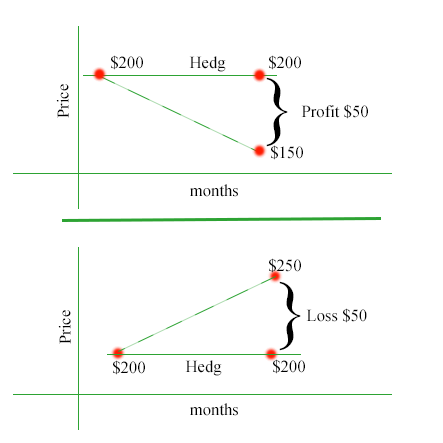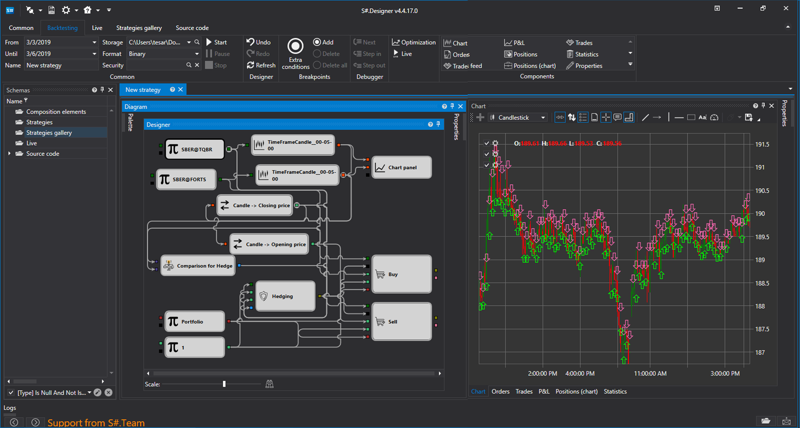Unfortunately,
insurance companies do not provide traders with insurance in case of adverse price changes in the market. However, the so-called i
nsurance mechanism exists, and is implemented through the futures exchange.
This insurance mechanism is called Hedging. Hedging is an option for
insuring assets against adverse price changes in the market, in which a trader buys an opportunity to buy and sell an asset (futures) in a subsequent period of time with fixed terms of the transaction. The name originates from the English hedge, which means insurance or protection.
 Hedging
Hedging uses the futures market, which reduces the risks of an adverse trend change in this market, in fact, a futures transaction is a replacement for an upcoming transaction in the cash market, while the futures position has the opposite direction of the position in the cash market, thus reducing the risk.
For example:The wheat producer is confident that its future crop will bring it profit in three months.
Provided that all farms get a good harvest, the price of wheat will decrease in the market. To reduce
the risk – hedging the risk, the wheat producer
buys a forward contract (not a standardized contract for the delivery of the underlying asset in the subsequent period, with the fixed price of the underlying asset), under which it will be able to sell
10 000 tons of grain at a price of
$200 per ton.
Now let's look at the possible scenarios:-
Let the harvest turned out good, respectively, the price on the market sank to
$150 per ton. In this case, the manufacturer executes its forward and earns:
$200 x 10 000t = $2000000-that is, it remains a winner;
-
Let the crop was born bad, while the price rose to
$250 per ton. The manufacturer performs its forward, while it receives
$2000000, and its losses are
$500 000. In this scenario, the buyer wins, but the manufacturer has insured itself. To avoid losing more.

When
hedging, a fixed-term
hedging contract is opened. at the same time, this contract itself is a financial asset, so it can be bought and sold, that is, to carry out normal transactions on the market.
The asset that is insured can be any asset from your portfolio and any asset that is only expected to be purchased. The market where the possibility of operations with an asset is implemented is a spot market (transactions in such a market are made immediately, usually within two days at most).
We can say that hedging contracts form a fixed-term or future market.
Let's look at another example that examines the possibility of compensating losses from the sale of an asset by selling futures and Vice versa:Let the organization acquire a tanker with oil, having a desire for subsequent resale. In the current period of time, it is not able to sell oil at current market prices, however, the organization sells a futures contract for oil. In the subsequent period, the organization sells oil and buys futures.
- Let's assume that the price of oil fell at the time of sale, respectively, when it is sold, the organization will suffer a loss, but the liquidation of the futures contract will give a profit that will cover the loss from the sale of the real product.
- Let's assume the situation has changed, and the price of oil has started to rise, respectively, the organization will make a profit on the sale, but the purchase of futures will bring a loss, but it should be covered by the profit received.
Thus, the loss is compensated in one market at the expense of profit in another, we can say this is comparable to an arbitration operation.
Such operations are possible because of the close relationship between the price on the real market and the futures market. Of course, we can not say that the prices in both markets are the same, since there are differences. For this reason, it is impossible to talk about an ideal hedge, in which losses are reduced to zero, but at the same time, the importance and possibilities of hedging are fully justified when trading.
Successful hedging depends on the degree of correlation of prices in the cash and futures markets, the higher the correlation, the more successful the hedging. Of course, there is a risk that changes in prices on the cash market will not be compensated by changes in prices on the futures market, which will result in a loss or profit. But this is how
hedging protects the underlying risk from the greater risk caused by the insecurity of an open position in the cash market.A market participant who insures their risk is called a
hedger, and the counterparty in the hedging contract may be:
- hedger's partner;
- other hedger (buyer or seller of the underlying asset, which also insures the risk, but in the opposite direction);
- financial speculator.The hedging strategy for participants is based on a unidirectional parallel change:
- current price of the underlying asset-spot prices;
- a prospective "futures" price.Operation of the hedge opens two trades at the same time:
- transactions with the underlying asset on the spot market;
- transactions on the futures market of the same asset.Hedging can be of various types, let's look at what types are:
By the type of instruments used in hedging:-
Exchange-traded instruments (futures, options), while contracts are opened exclusively on exchanges, and transactions have a third party-a Settlement Fee that tracks the performance of obligations. All contracts are independent derivative financial assets and items of purchase/sale operations.
It is worth highlighting the following positive aspects of such hedging:
- security,
- access to auctions,
- market liquidity.The disadvantages are standardized assets, strict requirements, and various restrictions on transactions.
- Over-the-counter instruments (forwards, options), while contracts are concluded outside the exchange, are one-time, do not have circulation on the market, and are not independently traded assets.
Positive aspect:
- Large flexibility in the choice of an asset and the terms of the contract. The disadvantages of such hedging are low liquidity with an increased risk of default, and increased transaction costs.
The next type is hedging by type of counterparty. It is divided into the following types:-
The buyer's hedge, in this case, the buyer's risks are insured, which are associated with a prospective increase in prices and deterioration of the transaction conditions. With such hedging, the most common operations are the purchase of forwards, futures, call options, as well as the sale of put options.
-
The seller's hedge, in this form, the seller's risks are insured, which arise when the asset's value potentially falls and the contract terms deteriorate. This hedging involves selling forwards, futures, and call options, as well as buying put options.
Hedge by the amount of risk that must be insured, is divided into the following types: - Full hedging, in which the entire volume of the transaction is insured.
- Partial hedging, in which only part of the transaction volume is insured. By the time the underlying transaction is concluded, the hedging is divided into:- Classic hedging, used with the application of a fixed-term transaction, which is concluded after the transaction with the insured asset.
- Anticipatory hedging, in which a fixed-term transaction is concluded in advance before the acquisition or sale of the insured asset. Hedging by asset type is divided into:-
Net hedging, in which the insurance contract is concluded for the same type of asset.
- Cross-hedging, in which the hedging contract is entered into for a different type of asset than the underlying one. Hedging under the terms of the contract is divided into:- One-sided hedging, in which the possible loss from price changes in the market is fully borne by one of the participants in the transaction – the buyer or seller.
- Two-way hedging, in which losses are distributed among all participants. It is worth noting that all the types of
hedging analyzed allow you to choose the most optimal strategy for the implementation of the trading mechanism.
Of course, it is worth saying that this type of operation is quite difficult for a beginner, and sometimes for an experienced user, it causes a large number of problems.
Today, the use of this type of operations is facilitated by implementing
hedging mechanisms in various trading systems and robots.
For example,
StockSharp has implemented an
"Hourglass" trading robot that allows h
edging using various methods and trading operations.
For
Designer users, the
"Hedging" cube is implemented, which settings allow you to protect against risks in ongoing trading operations.

In this way, building strategies is easier, and is reduced to configuring the cube and input parameters.

Remember that the types of hedging considered can be fully implemented using our SOFTWARE, including the implementation of these methods is considered in the
course of programming training.
The most important thing is to remember and not forget about the opportunities to save your profit, and hedging methods will come in handy